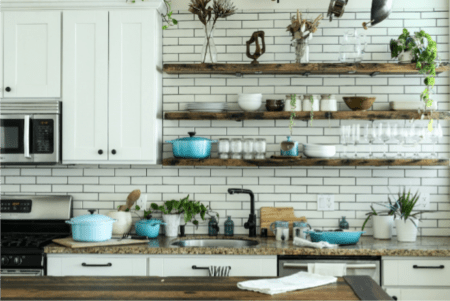With the rise of HGTV and Pinterest combined with the increase in time spent at home, home renovation projects are more popular than ever. In fact, over $400 billion was spent on home improvement and repair in 2020 alone!
Whether you’re buying a home in need of a little love or giving the home you already own a facelift, renovating a house allows you to deepen your connection with your house while customizing it to your particular wants and needs.
That said, home renovation is no easy task. It takes a great deal of planning and preparation, not to mention the time, effort, and money it takes to bring the project to completion.
There’s a lot to unpack, but if you’re interested in remodeling your home, you’ve come to the right place. Read on to learn everything you need to know about the home renovation process, including a few tips to help you navigate the project with minimal stress.
List Your Goals for Renovating a House
The first step in the home renovation process is to outline your goals. Why are you renovating your house? What do you hope to get out of the project?
Write down all the projects you want to complete during your home remodel, big and small. Take your time with this step, you don’t want to change your mind or add projects mid-renovation. This is a great way to go over budget and land yourself in a sticky situation.
Once you have your list of projects, put them in order of importance. The non-negotiables should be at the top, with the projects you’d be okay with cutting, if necessary, at the bottom.
Then, either through your own research or with the help of a contractor, put a ballpark cost next to each item.
Remember, when estimating costs, it’s always better to overestimate than under. Having money leftover is no problem; running out, on the other hand, can be a disaster.
Draw Up Your Budget
Speaking of money, it’s time to draw up your budget. Home renovations can be extremely pricey, depending on the rooms and projects your plan includes.
Kitchens, for example, are the most expensive rooms to renovate, with average remodeling costs soaring over $20,000.
There are a couple of options here. The first is to start your renovation plans well in advance of the projects themselves. That way, you have plenty of time to save up!
However, we know that’s not always an option. Sometimes renovations are urgent, and you don’t have time to gather the funds yourself. If this is the case, taking out a home renovation loan is your best course of action.
Companies like Plenti offer rapid approval and low-interest rates. You could have your renovation funds as early as tomorrow!
Allocate Your Funds
With the total amount you’re able to spend in mind, you can allocate your funds to individual projects. The list you made earlier will come in handy here.
When you compare your budget to the list of expenses, you’ll likely find that certain things need to be cut – and that’s okay.
Be sure to set aside 10% of your total budget for unexpected expenses. More often than not, renovation projects come with their fair share of these. After all, you never know what you’re going to find when you start tearing walls apart.
If you’ve been flying solo thus far, it’s a good idea to start working with contractors for this step. They can help you nail down more exact costs by giving you personalized estimates for materials and labor.
Consider DIY
One of the best ways to save money and get more out of your home renovation is to DIY at least a portion of it. That said, it’s crucial to know your limitations here.
If you’re a DIY newbie, it might be better to stick to the basics. Even those without any experience at all can handle projects like updating hardware and painting.
Those with more experience (or a lot of ambition) can tackle more difficult and demanding projects. However, there are two types of projects that should always be left to professionals: electrical and plumbing.
Unless you’re an electrician or a plumber yourself, you run the risk of spending more in the long run by attempting the DIY route. One small plumbing leak, for instance, can cause irreparable damage to your home over time.
How to Choose a Contractor
We touched on collecting estimates earlier; now let’s dive deeper into choosing a contractor. One of the best remodeling tips we can give you is to speak to multiple contractors before choosing the one who will renovate your house.
You’re entrusting them with your home; there’s nothing wrong with taking your time with collecting estimates and interviewing each candidate. Contractors are not only used to this, they expect it.
When you’re interviewing potential contractors, there are a few things we recommend asking:
- How many years of experience do you have?
- Do you have a copy of your contracting license?
- Can you provide me with a certificate of insurance?
- Do you have a list of references?
- What is your preferred payment schedule?
If a contractor can’t provide you with references, they’re not the one for you. And when you do get a list of references, call them! Ask past customers what their experience was like, what projects they completed, and if they would work with the contractor again.
As for the payment schedule, contractors typically don’t require payment in full upfront. If they do, proceed with caution, as they might not be the most reputable.
But even though you don’t have to pay the full amount right away, you do need to hammer out the payment details. How much time after project completion will you have to pay? What course of action is taken if something isn’t done to your satisfaction?
Create a Timeline
After you’ve chosen your contractor or team of contractors, you can begin creating a timeline. As we discussed above, the renovation process is rarely a linear timeline. There will be unexpected costs, projects, and setbacks.
So while it’s good to have a rough estimate of how long your renovations will take, there will be moments where you simply have to roll with the punches.
Sit down with your chosen contractor and discuss the remodel steps. Decide which projects will be completed first, how long each item should take, and which projects can be done at the same time.
Your schedule should include the time it takes to clean out your home, to ship the required materials, and any time off that the workers will be given. Mark out the tentative dates on your calendar, including a completion date (with the understanding that it might move).
Prepare for Your Renovations
As your renovation start date approaches, you’ll need to make preparations for yourself and your family. Depending on the type and depth of the projects you have planned, you might be able to stay in your home while they’re being completed.
However, living in a construction zone is inconvenient and can even be dangerous if you have young children or pets.
Let’s say you’re renovating your kitchen. You’re going to need to build temporary cooking and eating areas. If you’re renovating your master bedroom, you’ll need a place to sleep and somewhere to move your furniture.
Because living among half-completed renovations is such a hassle, it’s often better to leave the house until they’re done. Staying with a nearby friend or family member is an option. Or, if you have the funds, you could make a mini-vacation out of it and stay in an Airbnb or hotel while your home is under construction.
Be sure to give yourself at least 1-2 weeks to pack up your rooms and move your family to a temporary location, if necessary.
Get Started With Your Home Renovation Plans Today
When it comes to renovating a house, the best thing you can do is take your time. If you can, take time to draw up your plans, determine approximately how much those plans will cost, and then go from there.
In doing so, you can ensure that you know exactly what you want and that you have the funds to do it. Get started with the planning process today and you’ll be one step closer to making your home renovation dreams come true.
In need of more advice and information for bringing your dream home to life? Take a look at our blog!











